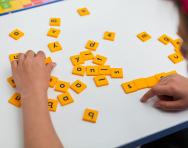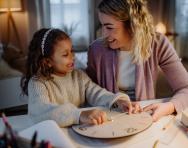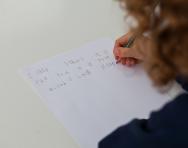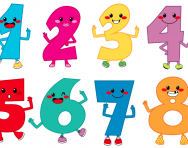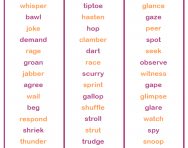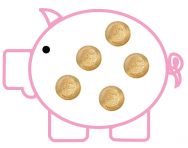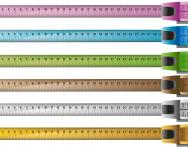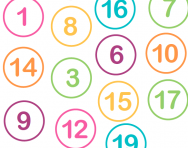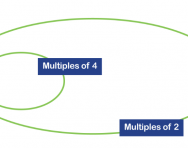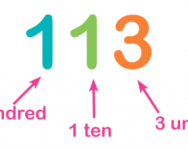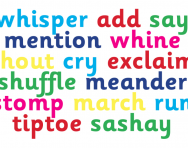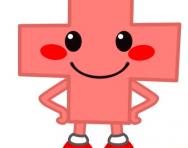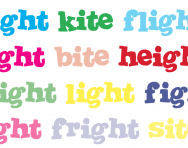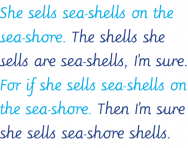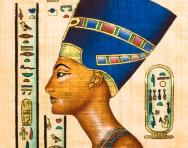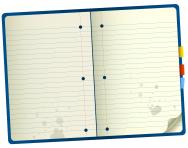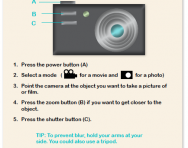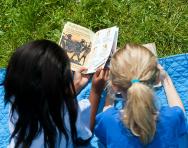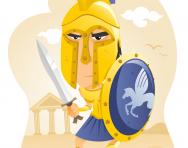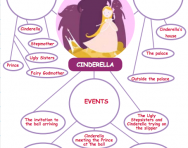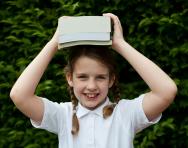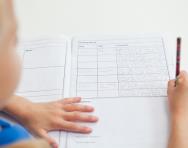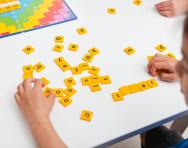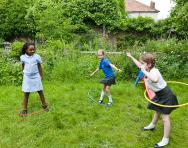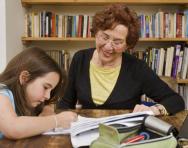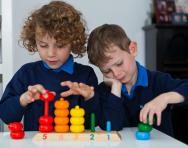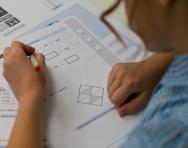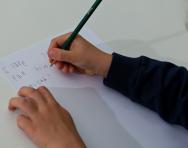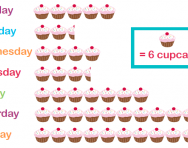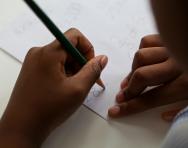Ks1 articles
10 ways word puzzles can help your child
Crosswords, word searches and hangman aren’t just handy ways to keep your child quiet for five minutes; they could also boost their learning in some surprising ways. Here’s how…
Best time-teaching products
Great toys, books and resources to help your child learn to tell the time on analogue and digital timepieces, from clock face recognition to estimating time differences on the 24-hour clock.
Teachers' tricks for division
Primary school teacher Phoebe Doyle has some tips and tricks to help your child with division work at home, offering an explanation of strategies using in school today as well as some useful practical exercises to try.
What is a free school?
How do free schools differ from standard primary schools? How do they operate and what do they teach? If you’re thinking of sending your child to a free school, or just want to know more about them, here’s a brief parents' guide.
Common handwriting problems and solutions
Illegible handwriting? Huge letters? Strange pencil grip? Struggles with left-handed writing? If your child is finding handwriting hard, perhaps it’s one of these four issues. Find out more about how to tackle these common problems with advice from the National Handwriting Association's Angela Webb.
Holidays in term time: the parents’ guide
Once your child is at full-time school, cheap term-time holidays become a thing of the past. But who sets school term dates, and is taking your child out of school for a family break really a big no-no? TheSchoolRun explains.
5 number and counting skills primary-school children need
Numbers are all around us, almost from birth! Teacher Phoebe Doyle looks at counting, a fundamental aspect of mathematical understanding, to help your child grab the basics (without confusion!) from day one.
Teachers' tricks for shape, space and geometry
Throughout primary school children learn about the properties of the shapes in the world around them (primary geometry, in other words). Phoebe Doyle offers some insiders’ tips on helping them master shape and space maths targets.
What is a word bank?
Word banks are useful tools to help improve children's writing in KS1 and KS2. Find out how to create one at home and make expanding vocabulary a whole-family project!
Teachers' tricks for money maths
Money is the ultimate ‘real-life’ maths resource. Here's how to make the most of this tool to improve your child's maths learning at home.
Teachers' tricks for weights and measures
Weights and measures can be a really fun area of maths to teach in school – but one that can leave parents unsure of how to help at home. Teacher Phoebe Doyle has some hints and suggestions.
What are number bonds?
If your child is in Key Stage 1, chances are they'll have told you they're learning 'number bonds'... but what are they? Teacher Alice Hart explains why children are taught these number pairs, and how you can help your child practise them at home.
What is a Venn diagram?
Venn diagrams are often used to sort data in primary school. Find out what parents need to know about how to complete and read a Venn diagram correctly, plus how they're used in the classroom in KS1 and KS2.
What is place value?
A good understanding of place value (the value of each digit in a number) is vital in primary-school maths. Our parents' guide explains how your child will be taught about units, tens, hundreds and thousands with number lines, arrow cards and more, as well as outlining how place value is used to help children visualise calculations.
What is subtraction on a number line?
Also known as the jump strategy or complementary addition, subtraction on a number line is a common technique in KS1 and KS2 maths, useful for helping children visualise that subtraction is finding the difference between two numbers. Teacher Alice Hart explains the method and how it's taught in primary school maths.
What are powerful verbs?
Using powerful, descriptive verbs can make a big difference to your child's writing. We explain what parents need to know about powerful verbs (and ordinary verbs!) when helping with primary-school homework.
Teachers' tricks for addition
Help your child with their addition work, from the basics in Reception to calculations in KS1 and KS2, with some teachers' tricks to help the learning stick.
What is a play script?
Children learn to read, write and perform play scripts as part of the English and drama curriculum in primary school. Find out about the features of this genre, as well as ways to support your child's learning at home.
What is rhyme?
From reading rhyming poems to identifying rhyme schemes and rhyming couplets, we explain everything you need to know to help you support your child's love and learning of poetry at home.
What are alliteration, assonance and consonance?
When analysing poetry your primary-school child might mention alliteration, assonance and consonance. We explain what they've been taught to look out for in literacy lessons.
What is an information text?
Information texts are an important part of primary school literacy lessons. We explain the features of this non-fiction genre, why note-taking matters and how to help your child at home.
What is a recount?
Has your child been asked to write a recount? Find out what the main features of this kind of non-fiction text are, plus how recounts are used in primary school literacy lessons.
What is instruction text?
We read instruction texts on an everyday basis. In primary school your child will be taught to recognise the main features and write increasingly complicated instruction texts as part of their non-fiction literacy work.
What is non-fiction?
Non-fiction texts are read, studied and written throughout the primary-school years. Our parents' guide covers instruction texts, recounts, information and explanation texts, persuasive writing and argument texts and explains what you need to know to support your child.
What are myths and legends?
Myths and legends are taught as part of the primary-school curriculum; as well as reading them your child will probably write their own version. We explain what parents need to know to support learning at home.
What is creative writing?
Children are encouraged to read and write a range of genres in their time at primary school. Each year they will focus on various narrative, non-fiction and poetry units; we explain how story-writing lessons help develop their story structure, grammar and punctuation skills.
What is a spider diagram?
Spider diagrams are common planning tools in the primary-school classroom, used in science as well as literacy. We explain what you need to know to help your child use a spider diagram when preparing a fiction or non-fiction piece of writing.
The primary school National Curriculum in England explained for parents
TheSchoolRun explains everything parents need to know about the National Curriculum for English primary schools.
Book reports: what parents need to know
Helping your child engage with their reading matter and improve their literacy skills, book reports are a homework staple. So what’s involved, and how can you make them easier for your child? Lucy Dimbylow explains.
The parents’ guide to after-school childcare: out-of-school clubs
Convenient and cost-effective, out-of-school clubs can be a good solution to the before- and after-school childcare dilemma. So what do you need to know before you sign up?
The parents’ guide to after-school childcare: childminders
With a home-from-home environment and smaller numbers than an after-school club, childminders are a popular choice for after-school childcare. Here’s what you need to know.
The parents’ guide to after-school childcare: relatives
Getting a grandparent or other family member to provide after-school childcare can be a dream come true – or a bit of a nightmare. Lucy Dimbylow looks at the pros, cons and practicalities.
What is a story setting?
Every story has a setting, and primary-school children learn to analyse story settings in other people's writing before using the same techniques in their own fiction writing. Read on for details of how story settings are taught in KS1 and KS2.
What is an academy?
More and more primary schools in England are converting to academy status. If your child’s school is planning to make the transition, what could it mean for them?
Does my child have dyscalculia?
What are the signs to look out for if you think your child might have dyscalculia or 'number blindness', and what can be done to help?
7 strategies to help defeat children’s fear of maths
What does it mean if your child has a fear of maths, and what can you do to help them get over it? TheSchoolRun offers a step-by-step plan to help you boost your child's confidence – and your own.
Dyspraxia: parents' questions answered
Dyspraxia, or Developmental Co-ordination Disorder (DCD), causes problems with language, perception and thought – most specifically issues with co-ordination. Around one in seven children has this learning difficulty and if your child is affected it can be hard to know how to help for the best. Here we answer some of the most common questions parents ask.
What is a pictogram?
Pictograms are introduced in Year 2 as a simple and engaging introduction to bar charts. We explain what your child needs to know about pictograms and how to read and create them, as well as explaining when and how they're taught.
What are inverse operations?
Inverse operations are opposite operations – one reverses the effect of the other. In primary maths we talk about the inverse to explain how addition and subtraction are linked and how multiplication and division are linked. Teacher Alice Hart offers examples of how and when your child will be asked to use the inverse operation in school, and practical ways to help them understand the concept.
Your child's new school year preparation plan
Each year group brings fresh challenges in literacy and numeracy. Want to give your child a head start? Primary teacher Phoebe Doyle offers some easy-to-action advice on tackling an objective from the year group your child is about to enter during the summer break.
